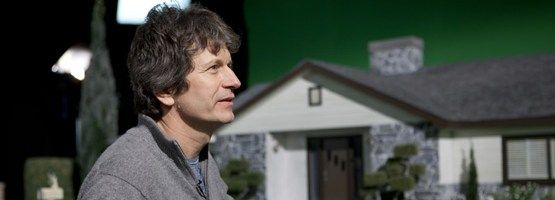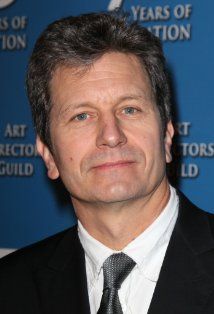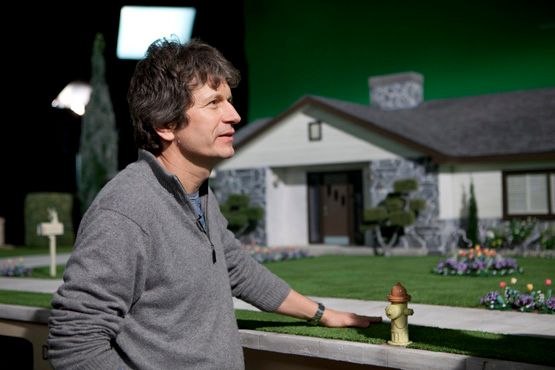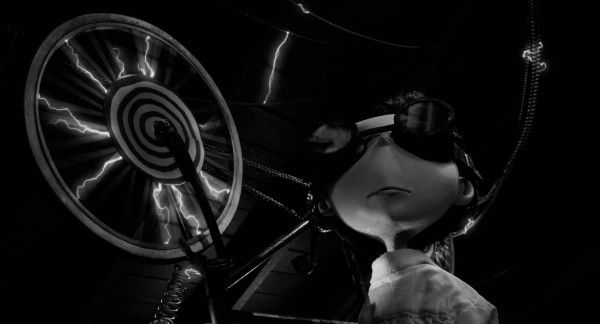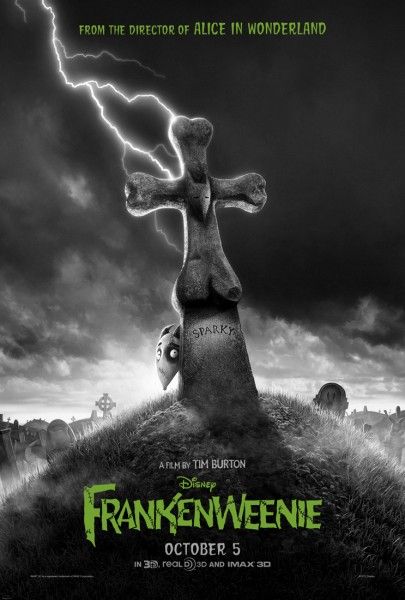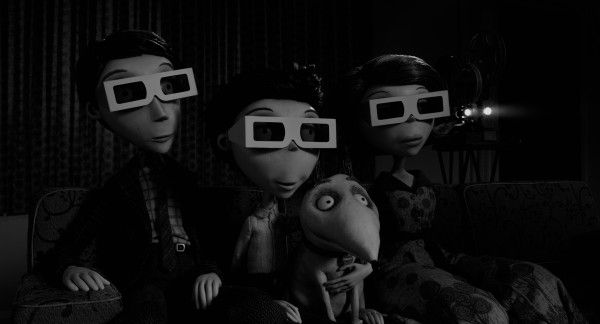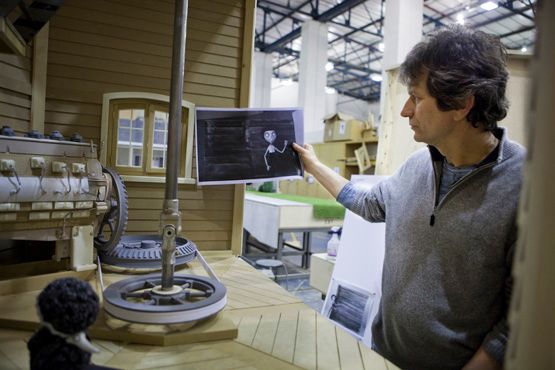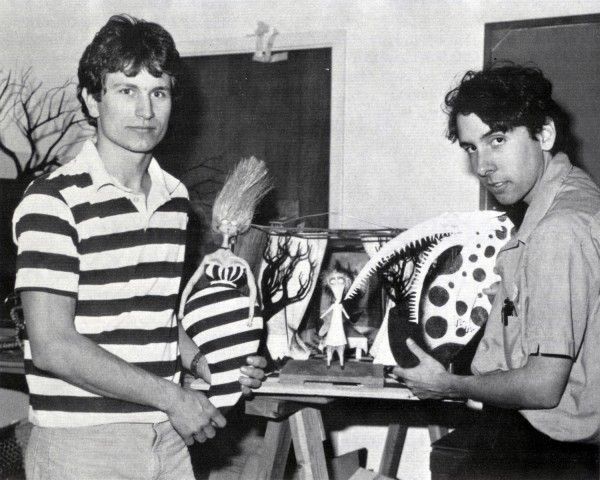The black and white, stop-motion animated 3D film Frankenweenie, from director Tim Burton and based on the ideas in his 1984 live-action short, is a heart-warming tale about a boy and his beloved dog. After unexpectedly losing Sparky, young Victor (voiced by Charlie Tahan) sews him back together and harnesses the power of science to bring his best friend back to life, but quickly faces unintended and sometimes monstrous consequences for his actions. The voice cast also includes Catherine O’Hara, Martin Short, Martin Landau, Atticus Shaffer and Winona Ryder.
During an early press day for the film, in which we got the chance to preview nearly 30 minutes of footage from the October 5th release, production designer Rick Heinrichs talked about his longtime collaboration and friendship with Tim Burton, what he loves about stop-motion animation, the process of taking the original drawings and turning them into three-dimensional figures, how the medium has changed with technology, and how surreal it is to go back and re-work the original idea for the film from 30 years ago. Check out what he had to say after the jump.
Question: How did you get involved with this project?
RICK HEINRICHS: Let’s see, 30 years ago, we did the live-action Frankenweenie, and it was a fruition of a certain period of development that Tim [Burton] and I had gone through from CalArts to Disney. That was the last thing we did at Disney, at that time. In fact, we did Frankenweenie after we developing another little TV show that we were trying to sell, called The Nightmare Before Christmas, and that ended up happening later, as well. I was actually surprised to find out that a stop-motion version of Frankenweenie was going to happen, but the more I thought about it, the more I thought, “What a great idea!” I loved the live action version, and there was something great about doing all of the design sets on stage, in addition to the location and the interiors, and it got my own wheels turning about doing live-action films, in the future, which I have continued to do. But then the idea of looking at this again, as much as I love it, there’s things that I wish we could have fixed about it. How often do you get to redo things like that? Doing it as a stop-motion animated film is appealing because that’s my passion. And, Tim and I did Vincent together, many years ago, as a kick-off for those. I think when you see the film, you can see how sophisticated it’s become. What I love about it is that it still feels handmade. You can still see the hand of the animator in there, and all of the passion that they’re putting into the character. You don’t necessarily think about it when you’re watching it, which is great. It does feel like the actors are really acting. Those animators are just amazing, the way they act through these puppets. In terms of design, it’s amazing to see it in black and white again, and really play with the tonal values in a much more controlled way, this time. When you’re doing a live-action film, you’re dealing with a lot more people and, as much as you want to control the sets and control the lighting, it’s like wearing boxing gloves to try to do something delicate. With stop-motion animation, the cinematographer is lighting the set, and the set decorators and the model makers and the animators are all people you’re talking directly to. You can fix things. It’s on a scale where it’s all fixable, and you can continue to manipulate things until it shoots. It’s a longer process of prep and production as well, so you can really bring more, continuity to bear, on the whole process.
What’s the most complex set in the film?
HEINRICHS: Well, the town is probably our most complex set. For any number of reasons of efficiencies, we really tried to restrict how that was going to get shot and be reasonable and, at the same time, give the sense of the character of the town, as a background of the people. Whenever we prepare for these things, we always design much more than we end up doing, so we have lots and lots of stores that we designed. It lives in this pseudo-Burbank world, which is where Tim grew up, coincidentally, but not exactly. It’s post-war Southwestern America. It shares a little bit of design similarity to Edward Scissorhands, in the scene of a neighborhood or a flat sense of normal with this one aberration, sticking up in the background, which is very much of a signature motif for Tim. A lot of what he tries to do is to establish a sense of what’s normal and show how that can be somewhat monstrous, in its own way. The idea of bringing your dog back to life is a nominally horrific idea, but it gets played out in this lovely way, and it ends up being a love story, really.
Did you use photo reference for it?
HEINRICHS: Yeah, we did what I would normally do on any film that’s live-action or animation. We did a lot of research. We pulled together a lot of that mid-century modern look of suburbia, that’s not really high-end stuff. It’s really more of the tract housing of the post-war era. It created its own rhythm and feel to it, and now I think it’s beautiful. It’s so flat and says so much about the people who live there. And then, the black and white just looks beautiful.
How did the New Holland idea come up?
HEINRICHS: New Holland occurred with Tim and John August, at the story stage. It was all about having Dutch day, and also about how American communities really take these Old World elements and they turn it into this flat, suburban thing. They knock down all the maple trees and they call it Maple Street. It’s this absconding of things out in the world, and making it your own thing. There was something characteristically American and charming about that, like Solvang. To be honest with you, I really think that it establishes a purpose for the windmill. Since we’re not making it part of a miniature golf course, as we did in the live-action film, we had to find another reason for it to be. But, that’s just my assumption.
Was there a reason why you made the sets were in color and the characters in black and white?
HEINRICHS: Yes, because the grass came that way. The reason why they’re in color is partly because we were replacing skies and set extending and using backgrounds, so there is a lot of digital work going on in the background. What I love is the fact that you don’t really think about that. All the stuff in the foreground is appropriately handmade and hand-animated. The look and feel of that, from the excellent visual effects people who did all the work on it, it’s part of their job to make it all work as one world, to make sure what they do is not photo realistically, which would be their normal bent. They’re actually matching a look and feel that’s already there. We were chromocene, so there were green screens behind elements. And, all of the black and white gets timed and sweetened in post-production. But, all the dailies were shown in black and white. As far as everybody was concerned, they were living in a black and white world. This is a much smaller range of graphic elements. We’re dealing with tone and shape and form and light, instead of color, and all the other stuff that comes with color. It’s out of that, that we’re trying to feeling and support the story. I think it looks beautiful. I think it does evoke a certain period of horror/science fiction films. It works in a dual way, and I know that Tim loves that stuff, as well.
Is that more liberating for you, or more challenging?
HEINRICHS: It’s both liberating and challenging. The challenge is that you have to pay much more attention to that specific stuff because you don’t have the other stuff to make it look great. Once you learn that and figure that out, then you realize that you are really dealing with elements. The tool kit is then atmospheric perspective, one foreground shape against another, lighting, texture and form. Originally, I was a sculptor, so that’s appealing to me, as well.
What was the process of taking Tim’s original drawings and translating them into these three-dimensional figures and creating a whole world from his sketches like?
HEINRICHS: I would have to go back to our early days of Disney when they were regenerating the studio. We were all working on The Fox and the Hound. It was initially exciting to be working on a Disney film, but then it just sagged in the middle, a little bit, although my kids like it. It’s a good movie. You’ve got to imagine this place with all these young animators, all of whom have been told that they’re special and are going to be amazing someday, and realize what it’s like to do the work of a big, corporate animated film. And, we would just do stuff on the outside. We’d make Super 8 movies, and do anything we could to keep our blood going. I’d always been a fan of Tim’s own work. I’m sure you’ve seen his sketches. What was appealing about them was the sense of character and beautiful line. I wanted to make it three-dimensional because I thought that his work was very three-dimensional, even though a lot of people at Disney thought it was very linear. Apparently, the hallmark of a Disney film is that they look very three-dimensional, back in those days. So, I just took it upon myself to make sculptures of his work, and there was just something different that happened. It was his intent and his look, but it was in light with form. It was just a very natural progression, to try to do those in a stop-motion animated film.
Has your job changed with like the advent of higher grade visuals and 3D?
HEINRICHS: Yes, it’s much harder to do our job because you see every pore. I think that it is an incredibly appropriate use of digital technology. It was amazing to see all of the improvements and progressions that had happened, by the time we did Nightmare in the early ‘90s with motion control, but that was with old film technology. Now, with digital cameras, which are much smaller, the ability to completely restructure the entire process using computers, you still end up with a very believably handmade product, but you’ve just helped yourself enormously with all the other things that happened. So, I’m a fan of technology. I’m not a Luddite. My problem has been with purely digital films. I feel the danger there is that the kind of short-cuts you end up having to take are the ones that are most telling in the main characters. I don’t feel that that’s the case with what we’ve been doing on Frankenweenie.
What were the discussions like, to differentiate the look of this film from everything else that Tim’s done?
HEINRICHS: There wasn’t a conscious effort to differentiate it. My feeling is that, if you do your due process and go back to the well, grab the original inspiration and just develop it from the ground up, it is just, by its own nature, going to be different. It wasn’t really intentional. With Tim, all of his films live in a Burton world, and there are different parts of that world that look a bit different. The point is never to intentionally make it not look like something else. The intent is always to go back to the source and figure out how that is informing this project.
Tim made the original Frankenweenie when he was a 25-year-old kid. Is it surreal to be revisiting it, this many years later, and to what degree are you trying to recreate what you did before?
HEINRICHS: You gain wisdom and you don’t make the same mistakes. When you’re that age, there’s a kind of energy to what you do. Because you don’t know enough not to make mistakes, there is something that is very infectious about the work. In the original Frankenweenie, there are a couple of things that are cringe worthy for me, like how we engineered the burning of the windmill. That’s always been a problem for me. But, it was a live-action film, and you’re on that rock, rolling down the hill. I do think back to that time with a lot of fondness about the young guys who were doing that stuff. It is so surreal to be able to go back and re-work something in a different way and, really, in a new way. Yes, it’s the same story, but it really is different and it has a different feel to it, as well.
What made you and Tim hit it off, all those, all those years ago, and how has your personal chemistry been, through all these films that you’ve done together?
HEINRICHS: It started because his talents and mine intermeshed, rather than competed. Probably a lot of it is that I just really dug what he was doing and wanted to see it develop. And, with any relationship over years, it evolves. We’ve gone our separate ways and done different things. I’ve worked with Tim for the last two and a half or three years, pretty consistently, and it feels great to be able to pick that up again. There’s a friendship there, and there’s been an evolution over the years, as well.
Did you meet working at Disney, or at CalArts?
HEINRICHS: Well, actually, he was at CalArts. I’d already gone through four years of art school, and I was the oldest guy in the first year there because I wanted to do animation. All these guys, who were years younger than me, including, you know, John Lasseter and Brad Bird, and other people like that, were in a grade level above me, so we didn’t actually start really working together until the studio.

